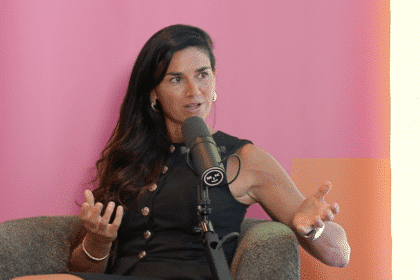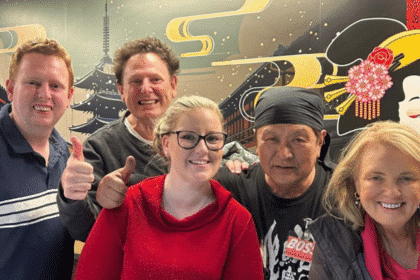Last month, in the News Corp Sydney auditorium, the media industry body ThinkNewsBrands partnered with Independent Media Agencies of Australia (IMAA) to hold a special in-person training and certification session to launch Publishing & News101 as part of the IMAA Academy’s education program.
Lead image: L-R: Aimie Rigas, director of audience development at Nine Publishing; Vanessa Lyons, CEO of ThinkNewsBrands.
The session highlighted the reach of the total news publishing industry, with 18.1 million Australians reading news every week.
The session explored the nation’s dynamic publishing and news media landscape, particularly the rise of multifaceted offerings across various platforms, including printed news, news websites, news apps, and category content publications. Participants gained valuable insights into the advantages of leveraging the nation’s diverse news and publishing channels alongside essential measurement tools and strategies for planning, buying, and booking news media.
Key insights from the day revealed the strength of category readership, proving that news publishing runs much deeper than just breaking news headlines. Australian news readers were revealed to be incredibly diverse in their interests, with close to 7 in 10 people reading three or more categories in addition to General News. Property, Sports, and Lifestyle and Health were all highlighted among the top news categories.
Through the use of first-party data, publishers can enhance engagement and build interest from the 97 per cent of Australians who consume written news publishing. One person who understands this practice better than anyone is Aimie Rigas, Nine Publishing’s director of audience development. B&T was honoured to be invited to the event and thrilled to have the opportunity to sit down with Rigas who was a special guest of ThinkNewsBrands and panellist at the event.
When Aimie first started out five years ago, her role simply didn’t exist in the publishing world. The role now spreads across all mastheads and is considered the voice of the newsroom, providing valuable insights that assist editorial, marketing and tech teams.
“It’s really easy to misinterpret data and think, ‘ This got the most pageviews, so it’s a thing our audience is most interested in. ‘ But sometimes, that’s just because it got a really good run on the homepage. And there’s actually this niche little nugget elsewhere that people found, and were really engaged with it, but we didn’t promote it well enough. So it’s just about feeding into the moments that matter,” Rigas said.
Rigas emphasised that her role is not about telling journalists what to write; she conceded that data can’t and shouldn’t tell them what to write or how to write it, but the two roles do work together to target audiences effectively.
“If you are the politics editor, you, of course, know politics better than I, but with our data, it’s my job to help you find an audience for that. So, if you truly believe this thing is the most interesting, engaging, and important thing, then you lean on our team to help you find an audience; if it’s important, it’s our job to make it interesting,” Rigas said.
There has already been a huge shift inside the newsrooms, with journalists framing their work around current trends and beginning to understand the data behind what works more and more. Rigas believes that just as journalists previously evolved to become their own editors and photographers, they are on a path to evolving now to a point where they fully understand the data beyond raw page clicks. “If I’ve done (my job) to its fullest, my role won’t exist anymore,” Rigas said.
Rigas used books as an example of the way a publication can utilise the data they have to better serve their audiences. Books, when compared to other kinds of stories, are never going to come first when it comes to clicks. They are also unlikely to get a spot on the home page or a successful run on socials. But when looking at engagement relative to these considerations, they are doing incredibly well. Nine saw this as an opportunity and created a book newsletter for readers who have a keen interest in this area that has attracted upwards of 60,000 people signing up and an open rate of 62 per cent.
Engagement with topics you are interested in is essential but there is a tendency for algorithms to keep you hooked on the same loop, not giving you new content. This is where Rigas’ role comes in: finding new ways to engage with audiences that may not necessarily go looking for new content. “I get frustrated when my TikTok algorithm pigeonholes me too deep in something. I think we, as media brands, have a role to play in not just showing people stuff that they’re already engaging with, but to open their minds to what else is happening in the world” Rigas said.
Utilising first-party data, Rigas is able to work alongside editorial teams to help find the best ways to frame news toward different readers with different interests and different news reading habits. The same mentality from the days of newspaper dominance still exists. Consumers want to see and engage with all the news from start to finish, from breaking news to sports, so they feel fully across the news of the day. It’s up to media brands to frame that in different ways to keep up audience engagement across the board and not just deliver the same topics that have worked before.
For B&T, the key takeaway from the day lies in how news publishing can be adapted to suit individual reader’s needs. It’s all about curation, finding ways to deliver the news that suit all lifestyles, not just the old man reading the physical newspaper or the Mum watching the nightly news but the people who have five minutes between meetings to stay in the loop and the ones who need something digestible they can read on their morning commute.









